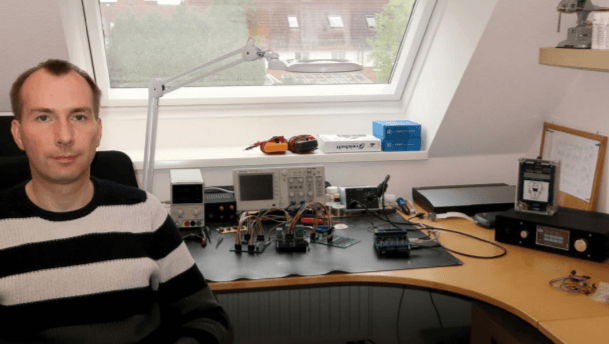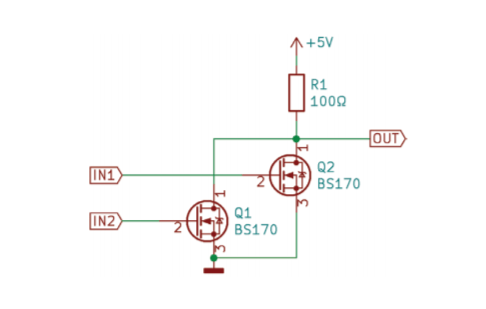A Spartan Workspace for Developing the MyNOR
Modern microcontrollers make it possible to stuff a ton of functionality into extremely small spaces. Applications that once required several chips can now be realized with one IC. Of course, you still must program microcontrollers, which is often done with the help of high-level programming languages. The disadvantage to this approach is that a designer can lose the link to what goes on at the port or transistor level within such devices. Dennis Kuschel consideredthis when he began working on building a discrete microcontroller with individual logic ICs. In this short post, Kuschel tells us a bit about his electronics workspace and what he works on in his free time, including the MyNOR computer.

A Bench for MyNOR and More
“Figure 1 shows my work space at home. I only own a few items of measurment equipment — an oscilloscope and two digital multimeters. I don't need anything else and I'm really not missing anything either. On my work bench you can see an example of the MyNOR computer where I have replaced 10 of the ICs with discrete transistor circuits (the cheerfully-coloured jumper wires).
“For Christmas in 1989 I received my first computer: a Commodore 64. I quickly wanted to do more than simply play games — I preferred to write my own programs and learn how such a device actually works. Four years later (I was then 17) I built a new computer from the salvaged parts of a C64 that I then programmed in assembler. During my electrotechnology studies in the 90s, the idea of building a CPU from simple logic gates and ICs came to me. A few years later MyCPU [1] was born. This is a computer built from many tens of logic ICs from the 7400-series CMOS logic family that runs a version of C64 Basic.
“The MyCPU received a lot of attention at computer festivals and hobby fairs, but many of those who were interested shied away from building their own because the cost of the complete MyCPU plus peripherals quickly approaches €1,000. That is why I decided (after 20 years) to begin a new project: a simple and as-cheap-as-possible computer that is, of course, entirely built from discrete parts. It had to meet two conditions. Firstly, it had to do without an ALU (Arithmetic Logic Unit) for the simple reason that the previously ubiquitous ALU chip 74LC181 is no longer available and alternatives have become too complicated. And, secondly, it would have to suffice with a single programmable memory IC (EEPROM).
“My new computer uses only a single NOR-gate for its arithmetic – an extremely simple logic unit that I chose because it is easily built using two MOSFET transistors and a resistor (Figure 2). All arithmetical operations (such as AND, OR, EXOR, add and subtract) are obtained in software from combining many individual NOR operations.

“Because of the central NOR gate I have christened my new computer MyNOR [2]. The total number of parts is so few that the entire circuit fits on a circuit board measuring 10 × 13 cm. Figure 3 shows the formal portrait of MyNOR, while the photo on the right shows what is where on the circuit board. It also contains a considerable number of peripherals: a 64 kB EEPROM for ‘mass storage’, while 8 digital inputs and 24 digital outputs provide communication with the outside world. These 32 I/Os allow the usual interfaces (RS232, I2C and SPI) to be realised in software.
SBC Excitement
“This single-board computer can achieve a surprising number of things. For example, I built a simple calculator in the operating system that can be operated via the RS-232 interface. This calculator primarily serves as proof that floating-point operations can be carried out by a single NOR-gate! Furthermore, the operating system contains a simple monitor program that allows assembly-language instructions to be entered. This way you can write your own assembly-language programs directly on MyNOR and store them in the EEPROM (this is a bit in the style of the C64). But it is, of course, also possible to upload a complete program. This is done using a text file that represents the binary program in a special format. A little bit of patience is required because the connection at 2400 baud is not blindingly fast.
“It becomes really exciting when this single-board computer is used without the umbilical cord to a PC. For this purpose I have developed two expansion boards. The first contains 20 pushbuttons, an LED and eight 7-segment displays along with the requisite transistors for driving them. The displays and pushbuttons are multiplexed in the usual way. I use the ‘pocket calculator’ built in this manner every day at work."
Want More MyNOR?
We will publish the full version of this article in the January/February 2021 edition of Elektor magazine. Don't miss the article for details about the pocket calculator and toothbrush timer that Kuschel built with the MyNOR.
Want ideas for your own dream workspace? Take a look at these electronics workspaces.
Tell Us About Your Workspace
Would you like to share information about your home electronics workspace with Elektor's global community of engineers and makers? Take soem time to fill out this form so we can follow up with you!
